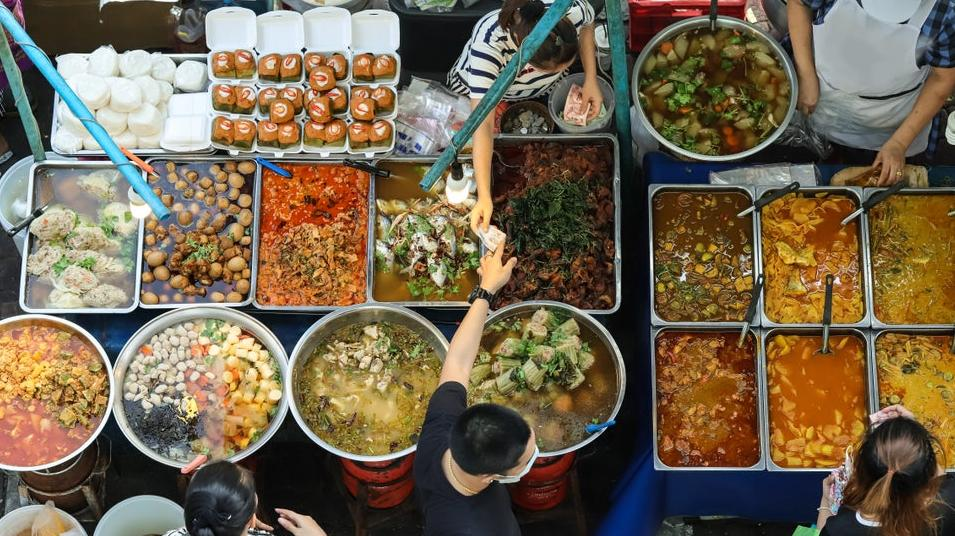The Difference Between Thai Food In America And Thailand
In the United States, Thai cuisine takes on a somewhat different (but equally delicious) form.
My ideal night in: a glass of wine, extra spicy Pad Thai with mock duck, an order of spring rolls, and a romantic comedy. I've been hooked on Thai cuisine since I was young, having grown up in Queens. Given that New York City houses Thai restaurants on nearly every street—thanks in part to the Thai government, which influences the ubiquity of Thai food in the States—I am spoiled for choices. But there is much more diversity to Thai food beyond what I've experienced.
After a recent trip to Thailand, I realized that there are both subtle and obvious distinctions between Thai food originating in Thailand and the Thai food served in the United States. Here are some of the biggest differences I found while traveling.
American vs. Thai portion sizes
One of the most obvious differences is in the typical portion sizes. Many of the meals I enjoyed in Thailand featured a variety of dishes shared amongst a group; this allows everyone at the table to sample a bit of every flavor and texture. Even in a non-shared-plates format, however, my individual entree was always notably smaller than what I'm accustomed to in the States.
American portion sizes are often determined with the idea that consumers will take home leftovers, or at least feel justified in covering the cost of the entree. However different the approach, in both the US and Thailand, the goal is of course to leave diners satisfied with what they consume.
Fork & knife vs. fork & spoon
Be it rice or roti, I grew up eating with my hands, a common practice in my South Asian household. My mom often jokes that biryani tastes better with your fingers than utensils—you are grasping every last bit of flavor in each morsel, she says!
In Thailand, the etiquette around eating is different from that of both my South Asian roots and the traditional American approach of eating with a knife and fork. Instead of a knife, Thai people use a spoon, even for items that are not liquid or broth-based. The spoon is held in the right hand, fork in the left, and the diner pushes the food onto the spoon with the fork, rather than jabbing the fork's tines directly down into noodles, rice, vegetables, or meat.
While Thai restaurants in America will often provide chopsticks at the table, in Thailand those utensils are reserved for standalone noodle dishes. Knives are not generally used during a meal, as most meats and vegetables are already cut into pieces that do not require a functional need for knives. In most cases, a spoon can be used to further section off food.
Thai herbs and spices
Spicy food is my love language, especially if it contains turmeric, chiles, and cilantro. Traditional Thai food is rich with regional herbs and spices; their inclusion is a testament to the way in which local ingredients form the Thai culinary foundation.
"Historically, Thailand was amongst the hub of trade in Southeast Asia and became a melting pot of flavors," says restaurateur Andy Chotsrileocha, who along with his mother transformed a hundred-year-old family heritage garden into Poomjai Garden, a farm-to-table restaurant in Bangkok geared toward nourishing the local community. "As a result, Thai food is influenced by Indian, Chinese, and Portuguese palates, allowing for many of their dishes to be a blend of spicy, sour, salty, sweet, and bitter flavors."
Turmeric, garlic, ginger, Thai basil, and lemongrass are among the signature flavors in Thai food. Though these ingredients are often present in American Thai dishes as well, the taste is likely less distinct—not quite as spicy or fresh—a consequence of our reliance on herbs and spices that have been imported from other countries.
Less meat, more vegetables
Before my trip to Thailand, I was nervous about how many vegetarian options I would find abroad. Though I eat a great deal of tofu at home, I did not want to grow bored of it in the event that it was the de facto meatless option at every meal. As it turns out, boredom was a complete non-issue: Not only was tofu beautifully incorporated into a variety of both savory and sweet dishes, but Thai food on the whole offers abundant vegetable and rice dishes that naturally appeal to a vegetarian diet. If Thailand's cuisine has fewer plant-based meat substitutes to choose from, it's because there's less meat that needs to be substituted in the first place.
Though American Thai food features a greater proportion of meat alongside smaller servings of vegetables and rice, in Thailand the ratio is reversed. Dishes tend to incorporate lots of local produce including plants (i.e. edible lotus), fruits (i.e. coconuts, mangoes, bananas, and passionfruit), and various vegetables that are steamed, fried, or served raw. Meanwhile, American staples such as bread, potatoes, and dairy products are rarely present in Thai cuisine.
"For centuries, gardening was part of the Thai way of life and an economic way of living," Chotsrileocha says. "For my family, we grew various kinds of vegetables and fruits for domestic consumption. Accordingly, Thai food was supposed to be simple; the ingredients should be easy to find within your household."
